Uterine fibroids are a common health problem for many women worldwide. They cause heavy bleeding, pelvic pain, and pressure, which can impact daily life. As awareness grows, more women seek non-surgical options to treat fibroids. Uterine Fibroid Embolization (UFE), also known as uterine artery embolisation, has gained popularity as a safe, minimally invasive procedure. India is now a leading destination for advanced gynecological treatments, attracting many international patients. This guide covers everything you need to know about UFE in India, including its process, benefits, costs, and patient experiences.
In India, uterine fibroids, non-cancerous growths in the uterus that can result in heavy menstrual flow, pelvic pain, and reproductive problems, can be effectively treated using the cutting-edge, minimally invasive surgery known as uterine fibroids embolization (UFE). For many women seeking relief without having a hysterectomy or myomectomy, UFE is increasingly the favored option as knowledge of less invasive surgical treatments increases. India is a top location for UFE, providing patients with high-quality care, better results, and quicker recovery periods thanks to its developing healthcare infrastructure, highly qualified interventional radiologists, and reasonable treatment rates.
Conclude The Definition Of Uterine Fibroid Embolization Treatment

Uterine Fibroid Embolization Treatment
Explain The Uterine Fibroid Embolization Treatment For Beginners – UFE Cost In India
To treat uterine fibroids, a minimally invasive surgical technique called Uterine Fibroid Embolization (UFE) or Uterine Artery Embolization (UAE) involves cutting off the fibroids’ blood supply. UFE is carried out by an interventional radiologist who guides a catheter to the uterine arteries via a tiny incision made in the wrist or groin.
The fibroids gradually shrink and die as a result of the injection of tiny, biocompatible particles that obstruct the blood arteries supplying them. Compared to typical surgical procedures, this treatment preserves the uterus and offers a faster recovery time while efficiently relieving symptoms, including heavy menstrual bleeding and pelvic pressure, without the need for surgery.
- Intramural: Grow inside the uterine wall
- Submucosal: Protrudes into the uterine cavity
- Subserosal: Extends outside the uterus
- Cervical: Develop in the cervix
Fibroids often cause symptoms like heavy menstrual bleeding, pelvic pain, bloating, and frequent urination. For some women, they can also lead to fertility issues or anemia due to blood loss.
Prevalence and Risk Factors
Globally, fibroids affect up to 70% of women by age 50. In India, research shows a significant number of women are diagnosed with fibroids, especially in their 30s and 40s. Factors that increase the risk include hormonal changes, genetics, obesity, and late pregnancies. As awareness rises and healthcare access improves, more Indian women are now seeking treatment options.
When A Infertile Couple Need To Consider UFE Treatment In India? – UFE Clinic Near Me
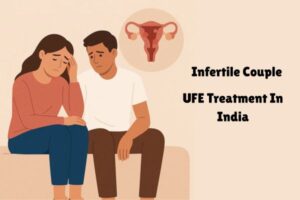
UFE Treatment In India
When trying to conceive, infertile couples in India frequently look into several treatment options, particularly if they have underlying medical issues like uterine fibroids. When fibroids are found to be a potential cause of infertility or repeated pregnancy loss, uterine fibroids embolization (UFE) is taken into consideration.
Although not all fibroids have an impact on fertility, those that cause uterine cavity distortion or disrupt embryo implantation can make it more difficult to conceive. UFE is a non-surgical option in certain situations to eliminate the effects of fibroids without damaging the uterus. After a comprehensive review by a fertility doctor and after other less invasive options have failed to produce results, infertile couples should think about UFE.
Steps To Choose UFE Treatment In India – Benefits Of SFor Fertility
India offers high success rates for UFE with a safe track record. The country boasts top interventional radiologists and gynecologists skilled in the latest techniques. The costs are often significantly lower than in Western countries, making India a popular choice for medical travelers. Many hospitals are accredited and follow strict safety standards, giving patients confidence in their care.
|
Step |
Description |
|
Identify Symptoms |
Recognize common fibroid-related symptoms such as heavy bleeding, pelvic pain, frequent urination, or fertility issues. |
|
Consult a Gynecologist |
Visit a gynecologist to confirm the presence of fibroids through clinical examination and imaging tests like ultrasound or MRI. |
|
Get Referred to an Interventional Radiologist |
If fibroids are symptomatic and surgery is not preferred, your doctor may refer you to a UFE specialist. |
|
Undergo Diagnostic Evaluation |
Detailed imaging (usually MRI) helps assess fibroid size, location, and suitability for UFE. |
|
Discuss Treatment Options |
Review alternatives (like medication, myomectomy, or hysterectomy) and decide if UFE aligns with your health and fertility goals. |
|
Choose a Certified Hospital/Clinic |
Select a reputable hospital or fertility center in India that offers UFE with experienced interventional radiologists. |
|
Understand the Procedure & Recovery |
Learn about the UFE process, expected recovery time, potential risks, and post-procedure care. |
|
Review Cost and Insurance |
Confirm treatment cost, inclusions, and whether your insurance policy covers the procedure. |
|
Schedule the Procedure |
Once fully informed, book your UFE appointment and follow pre-procedure instructions. |
|
Follow Post-Treatment Care |
Attend follow-ups, manage symptoms as advised, and monitor improvements over the next few months. |
Check Out The Listing Of UEF Treatment Cost In India – Uterine Fibroid Embolization Treatment
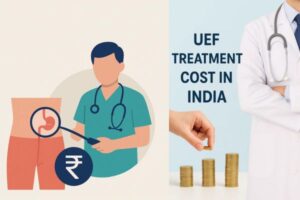
UEF Treatment Cost In India
By cutting off the fibroids’ blood supply, uterine fibroids can shrink and their symptoms can be reduced by uterine fibroids embolization (UFE), a minimally invasive surgery. The city, hospital, or clinic selected, the level of experience of the treating professionals, and the complexity of the case are some of the variables that can affect the cost of UFE treatment in India.
India is a well-liked location for medical tourism since it is renowned for providing excellent healthcare at costs that are lower than those of other nations. For assisting people in selecting a healthcare provider, we will examine the approximate prices of UFE treatment in several Indian cities in this guide.
|
City |
Estimated UFE Cost (INR) |
|
Hyderabad |
₹90,000 – ₹1,50,000 |
|
Mumbai |
₹75,000 – ₹1,50,000 |
|
Delhi |
₹1,12,554 – ₹1,76,046 |
|
Bangalore |
₹1,12,554 – ₹1,70,274 |
|
Chennai |
₹1,15,440 – ₹1,65,945 |
|
Pune |
₹1,00,000 – ₹2,50,000 |
|
Kolkata |
₹1,08,225 – ₹1,63,059 |
|
Ahmedabad |
₹96,681 – ₹1,60,173 |
|
Jaipur |
₹1,01,010 – ₹1,61,616 |
|
Noida |
₹1,08,225 – ₹1,80,375 |
How To Recognize Who Is A Suitable Patient For Uterine Fibroid Embolization Treatment In India?
Most women with symptomatic with qualify for UFE. Ideal candidates are those not seeking pregnancy or who have fibroids that are not too large or too numerous. Contraindications include infections or certain vascular conditions. Your doctor will evaluate your health and fibroid type to recommend the best plan.
- Women with symptomatic fibroids
- Non-surgical patients undergo UFE treatment
- Women who are willing to preserve their uterus
- Those who don’t have any issue with fertility
- Those women are in good health, or their daily lifestyle
- If a woman has enlarged fibroids
It’s critical to speak with an expert who can assess your unique situation and decide whether UFE is the best course of action. A thorough evaluation that includes imaging tests such as an MRI or ultrasound and a thorough medical history can help determine whether you are a good candidate for UFE.
Uterine Fibroid Embolization Treatment Success Rate In India By Previous Successful Treatment
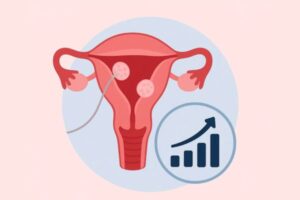
UFE, Success Rate In India
In India, women with symptomatic uterine fibroids are increasingly turning to Uterine Fibroid Embolization (UFE) as a safe, less invasive therapeutic option. The goal of this surgery is to stop the blood supply to fibroids, which will cause them to shrink and relieve related symptoms like frequent urination, pelvic pressure, and heavy menstrual bleeding.
Interventional radiologists conduct UFE, which is a successful substitute for surgical procedures such as myomectomy or hysterectomy. More women are choosing UFE as a uterus-preserving procedure that offers quicker recovery times and fewer difficulties as a result of India’s improved healthcare infrastructure and the availability of qualified experts around the country.
|
Clinic/Hospital Name |
Success Rate |
Notes |
|
World Fertility Services Clinic |
90-95% |
No publicly available data on UFE success rate. |
|
Fertility Centre Nepal |
80-90% |
Specializes in IVF and surrogacy; no data on UFE success rate. |
|
Go IVF Surrogacy Center |
70-80% |
Focuses on IVF and surrogacy; no data on UFE success rate. |
|
Max Healthcare Hospital |
85–90% |
Offers UFE with high success rates for symptom relief. |
|
Manipal Hospitals |
85–90% |
Provides UFE with significant symptom improvement. |
|
Aster Medcity Hospital |
85–90% |
Reports high success rates with over 5,000 UFE procedures performed. |
What Are The Following Steps To Check The Procedure Of UEF Treatment In India?
If an infertile couple is enthusiastic to avoid the hysterectomy surgery, instead of choose the UFE treatment. The process of Uterine Fibroid Embolization treatment in which IVF specialists blocking the blood circulation to the uterus to shrink the fibroid balls to recover into a normal stage.
Most of the infertile women suffer from uterine fibroid issues due to poor health or diet, certain infections that cause pain during the period or pregnancy. However, our expert writers write down each step to get familiar with the whole procedure of uterine fibroid embolization treatment in India at an affordable cost.
Steps To Consider Each Factor To Get To Know Beforehand The Uterine Fibroid Embolization Treatment
Preparation Before Procedure
Before UFE, you’ll undergo tests like an ultrasound or MRI to map fibroid locations. Your doctor will review your medical history and advise on medications. You may be asked to avoid food and drinks for a few hours. Discuss any allergies or medications with your healthcare team.
Step-By-Step Procedure
UFE is usually done under local anesthesia with sedation. A tiny incision is made in your groin or wrist. A catheter is threaded into the uterine arteries, guided by real-time imaging. Embolic particles are then released to block blood flow. The whole process typically takes 1-2 hours. Afterward, you’ll be monitored for a few hours in the hospital.
Post-Procedure Care & Recovery
Most women return home the same day or after an overnight stay. Recovery generally takes about a week. Common side effects include cramping, fatigue, and light bleeding. Doctors recommend pain relief, rest, and avoiding strenuous activity. Follow-up scans ensure fibroids are shrinking as expected.
Medical Tourism & Choosing The Right Facility
India’s main medical hubs for UFE include Delhi, Mumbai, Bangalore, and Chennai. When selecting a hospital, check for international accreditation, experienced doctors, and positive patient reviews. Planning your trip involves securing a visa, booking accommodations, and understanding travel tips. Many clinics assist international patients with logistics and language support.
Insurance & Payment Methods
Some private insurance policies in your country may cover part of the treatment. Cash prices are often negotiable, and hospitals sometimes offer discounts for international patients. Financing plans and installment payments are also available at several top clinics.
What Are The Risks & Limitations Of Uterine Fibroid Embolization Treatment In India?
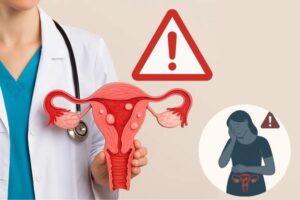
Risks & Limitations Of Uterine Fibroid Embolization Treatment In India
Even though Uterine Fibroid Embolization (UFE) is generally accepted as a safe and successful substitute for surgery in the treatment of uterine fibroids, it is crucial that patients fully comprehend the process before proceeding. UFE has some factors that may affect its appropriateness for specific people, just like any other medical treatment.
Patients and their healthcare professionals can make well-informed decisions based on medical history, reproductive objectives, and general health by being aware of the possible dangers and limits related to UFE. Determining whether UFE is the best course of treatment requires a thorough assessment and consultation with a licensed interventional radiologist.
Often, certain treatments come with minimal risks and limitations, for instance, uterine fibroids embolization treatment, in which several risks are listed in the further bullets or paragraphs. We abandoned some risks in the following points such as.
Potential Risks And Complications
Post-embolization syndrome, characterized by fever, pain, and nausea, is common but manageable. Rare side effects include infection or unintended embolization that can affect other organs. Weighing benefits against risks with your doctor is essential.
Limitations Of UFE Treatment
UFE may not be suitable for very large or multiple fibroids. It can also impact future pregnancies, so women wanting children should discuss this thoroughly with their doctor. Not every fibroid type responds equally well to embolization.
Alternative Treatment Available In India
For some women, surgery may be better. Options include myomectomy (removal of fibroids) or hysterectomy (removal of the uterus). Medical therapies, like hormonal pills, can control symptoms temporarily. New procedures like MRI-guided focused ultrasound are also emerging, but are less common.
Which Age Of Women Is Perfect For Uterine Fibroid Embolization Treatment In India? – Women’s Age For UFE Treatment
For women with symptomatic uterine fibroids, Uterine Fibroid Embolization (UFE) is a minimally invasive and successful therapy option. Women in India who are looking for alternatives to surgical procedures like hysterectomy are increasingly choosing this technique.
UFE is most frequently advised for women between the ages of 30 and 50 who are having heavy monthly flow, pelvic pain, or pressure symptoms and want to protect their uterus, even though fibroids can afflict people of any age.
|
Age Group |
Suitability for UFE |
Short Description |
|
Under 30 |
Less Common |
UFE is rarely recommended unless symptoms are severe and other treatments have failed; fertility concerns are also considered. |
|
30–40 |
Highly Suitable |
Ideal candidates, many women in this age group experience symptomatic fibroids and prefer uterus-preserving options. |
|
41–50 |
Highly Suitable |
The most common age group for UFE; women often experience significant symptoms and seek relief without surgery. |
|
Above 50 |
Conditionally Suitable |
UFE can be considered post-menopause if fibroid symptoms persist, though symptoms often reduce naturally. |
Determining the efficacy and safety of this treatment requires an understanding of the optimal age and individual appropriateness.
How Indian Government Help Infertile Couples Or Parents Who Are Needy For UFE Treatment In Hospitals?
To assist infertile couples and women with uterine fibroids, particularly those requiring treatment with Uterine Fibroid Embolization (UFE), the Indian government has launched some initiatives. Multifarious health programs and public hospital services have been implemented to increase the accessibility and cost of cutting-edge therapies like UFE in recognition of the psychological and financial toll that infertility and related gynecological diseases take.
Economically disadvantaged groups are intended to be able to access quick diagnosis and minimally invasive operations through Ayushman Bharat programs, state-sponsored health insurance, and subsidized care in government institutions. These initiatives show the nation’s growing dedication to women’s wellness and reproductive health.
How Much Time Take For Recovery Afterward Of UFE Treatment In India? – UFE Treatment In Delhi
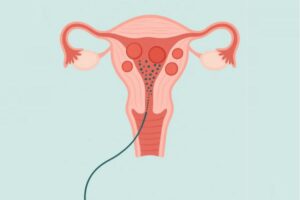
UFE Treatment In Delhi
When compared to more conventional surgical treatments like a hysterectomy, recovery following Uterine Fibroid Embolization (UFE) in India is typically rapid. The initial healing period usually lasts 7 to 10 days, and most women can anticipate being in the hospital for 1 day or less. Prescription drugs can be used to treat mild to severe discomfort, exhaustion, or cramping that individuals may suffer from at this time.
Depending on each patient’s unique health situation and how the body reacts to the surgery, full recovery, including a return to regular activities and employment, is typically accomplished in two to three weeks. To promote a speedy healing process, Indian institutions that offer UFE frequently offer follow-up care and post-procedure support.
Conclusion
Uterine Fibroid Embolization is a reliable, minimally invasive fix for women suffering from fibroid symptoms. Indian healthcare facilities offer top-quality care at a fraction of Western prices, making it an ideal destination for medical tourism. If fibroids affect your quality of life, consider UFE—your path to relief may be just a consultation away. With proper guidance and planning, World Fertility Services can help ensure a smooth journey to healthier, happier living.
Table of Contents

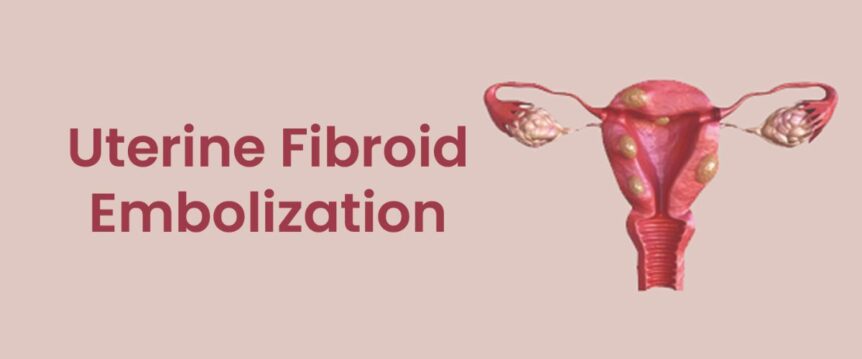
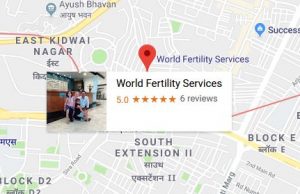
 WhatsApp us
WhatsApp us